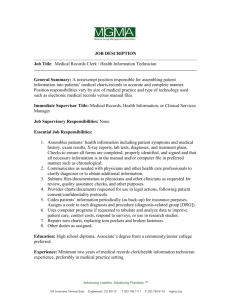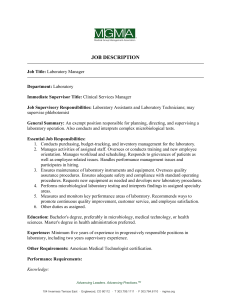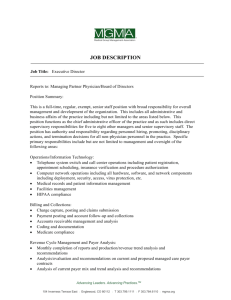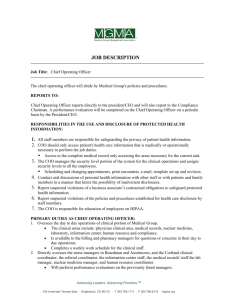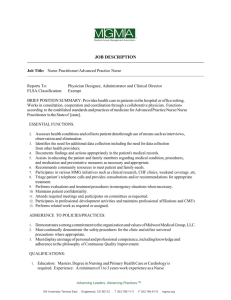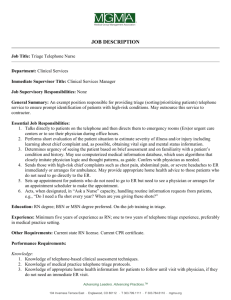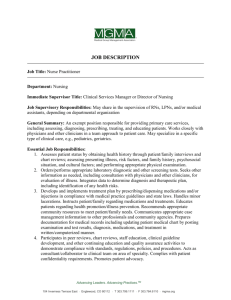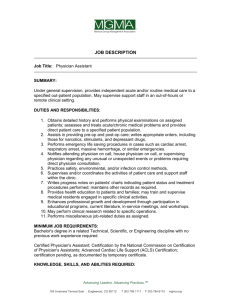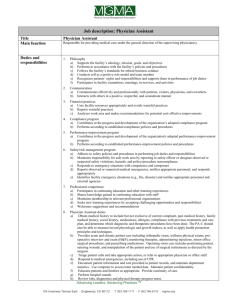Body of Knowledge quiz - Medical Group Management Association
advertisement
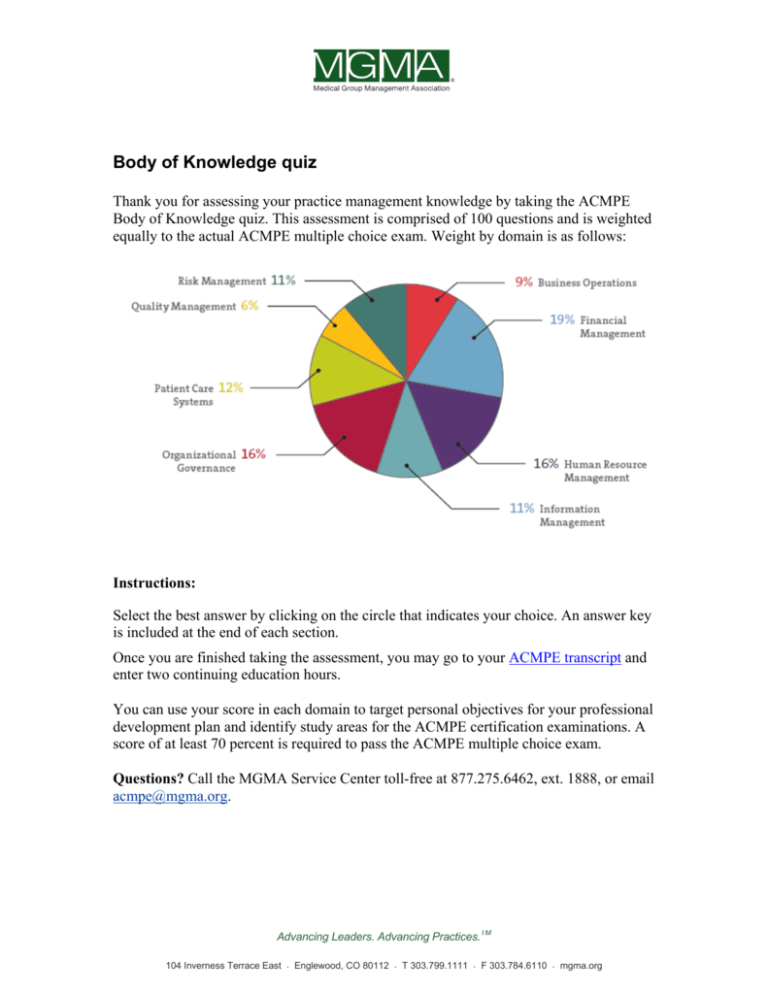
Body of Knowledge quiz Thank you for assessing your practice management knowledge by taking the ACMPE Body of Knowledge quiz. This assessment is comprised of 100 questions and is weighted equally to the actual ACMPE multiple choice exam. Weight by domain is as follows: Instructions: Select the best answer by clicking on the circle that indicates your choice. An answer key is included at the end of each section. Once you are finished taking the assessment, you may go to your ACMPE transcript and enter two continuing education hours. You can use your score in each domain to target personal objectives for your professional development plan and identify study areas for the ACMPE certification examinations. A score of at least 70 percent is required to pass the ACMPE multiple choice exam. Questions? Call the MGMA Service Center toll-free at 877.275.6462, ext. 1888, or email acmpe@mgma.org. TM Advancing Leaders. Advancing Practices. 104 Inverness Terrace East . Englewood, CO 80112 . T 303.799.1111 . F 303.784.6110 . mgma.org Business Operations 1. Which of the following is NOT considered an effective step in developing a procedure manual? A. Selecting a staff task force to organize the process. B. Purchasing a model procedure manual as a guideline. C. Obtaining support from the board of directors. D. Appointing a staff member to write all procedures. 2. Which of the following plans should be developed for each functional area within an organization? A. Business plan. B. Operational plan. C. Financial plan. D. Strategic plan. 3. What is materials management? A. Centralized receipt and storage of goods, supplies, equipment and furniture. B. Maintaining appropriate levels of goods in storage and user department locations. C. Maintaining an appropriate level of supplies at an acceptable cost and having them available when needed. D. The communication process between a buyer and a seller of products. 4. Which of the following defines just-in-time inventory? A. Supplies that arrive when inventory is optimal. B. Supplies that arrive when you need them. C. Supplies that arrive but that you did not order. D. Supplies that are shipped from back order. 5. What is the best approach when planning for future space needs for a medical practice? A. Design a layout that is the least expensive today and budget for redesign costs in future years. B. Design a layout that provides for maximum flexibility at a reasonable cost. C. Design a layout that best meets current needs. D. Devise a detailed plan outlining layout changes for the next five years. TM Advancing Leaders. Advancing Practices. 104 Inverness Terrace East . Englewood, CO 80112 . T 303.799.1111 . F 303.784.6110 . mgma.org 6. What is target marketing? A. A business strategy to identify and market to a specifically defined market segment. B. A broad array of research efforts used to understand the nuances of a particular market. C. A marketing mix that includes price, place, product and promotion. D. A deliberate effort to maintain mutual understanding between a medical practice and its publics. 7. The responsibilities of a medical practice executive include identifying, assessing and addressing new legal and financial issues. The successful executive should: A. Contact an appropriate advisor first. B. Know when to seek counsel from an appropriate advisor. C. Base decisions on a variety of legal and financial references. D. Be an expert in every situation. 8. What is marketing mix? A. Product/service, price, promotion and place. B. Television, radio, print and electronic media. C. Demographic population. D. Budget, plan, mission and vision. 9. Who is a stakeholder in the medical practice? A. Only people who own stock in the medical practice. B. Anyone who is affected by the medical practice. C. Patients, employees and owners of the medical practice. D. Only an owner or employee of the medical practice. Business Operations key: 1.D 2.B 3.C 4.B 5.B 6.A 7.A 8.A 9.B TM Advancing Leaders. Advancing Practices. 104 Inverness Terrace East . Englewood, CO 80112 . T 303.799.1111 . F 303.784.6110 . mgma.org Financial Management 1. In a cash basis accounting system, capital equipment purchases are recorded as which of the following? A. Debit equipment, credit cash. B. Debit accounts payable, credit accounts receivable. C. Debit cash, credit equipment. D. Debit accounts receivable, credit accounts payable. 2. In planning cash reserves for a medical practice’s annual operating budget, which of the following should take place? A. Have providers prepared for a capital call. B. Establish a working cash line with a lender. B. Avoid shortfalls by closely monitoring cash flow. D. Budget at least 30 days’ cash on hand. 3. What is the primary purpose of developing a policy on internal cash control? A. To provide a secure place for storage of cash and checks. B. To reduce errors in bank reconciliation. C. To ensure that patient payments are deposited daily. D. To protect cash collections from theft or fraud. 4. Which of the following steps will NOT reduce the risk of fraud or embezzlement? A. Reconciling posted cash receipts with monthly bank statement. B. Giving receipts to patients who pay cash over the counter. C. Ensuring that employees who handle cash disbursements also prepare accounting records. D. Requiring receipts for petty cash disbursements over $50. 5. On what does an efficient accounts receivable management process focus? A. The initial encounter. B. When the account is 60 days old. C. Remittance follow up. D. When the account is 120 days old. TM Advancing Leaders. Advancing Practices. 104 Inverness Terrace East . Englewood, CO 80112 . T 303.799.1111 . F 303.784.6110 . mgma.org 6. Which of the following applies to the Medicare resource-based relative value scale? A. Supplementary medical insurance. B. Medicare as the secondary payer. C. Physician fee schedule under Medicare Part B. D. Prospective payment for inpatient care. 7. Which of the following is NOT essential to effectively manage accounts receivable? A. Consistent follow-up procedures. B. Comprehensive billing system. C. Initial data collection. D. Electronic remittance. 8. How are bad debts determined? A. When the patient has been diagnosed as terminally ill. B. When an account is determined to be uncollectible. C. When the provider has not paid his or her share of overhead. D. When a bad check has been received from a patient. 9. What is the fundamental purpose of a medical practice income statement? A. To provide accurate information for income distribution. B. To summarize the events that took place during an accounting period. C. To keep financial institutions informed on practice liability. D. To educate stockholders to facilitate better decision making. 10. Which of the following is NOT a Generally Accepted Accounting Principle? A. There is a direct relationship between the cost of a long-lived asset and the revenue generated by the asset. B. Assets and liabilities are generally recorded at their historical cost. C. The timing of the recognition of expenses incurred for revenue earned depends on the nature of the expense. D. Revenue from services should be recognized when the practice performs the service. 11. Which of the following is NOT a characteristic of an effective financial operating report? A. Accuracy. B. Extensiveness. C. Clarity. D. Timeliness. TM Advancing Leaders. Advancing Practices. 104 Inverness Terrace East . Englewood, CO 80112 . T 303.799.1111 . F 303.784.6110 . mgma.org 12. Which of the following is an element in the financial investigation for due diligence in a practice valuation? A. Verification of employee education. B. Assessment of clinical quality. C. Assessment of payer mix. D. Verification of corporate status. 13. Which of the following employee payroll withholdings is capped at the federal wage base? A. State income tax. B. Medicare tax. C. State unemployment insurance. D. Social security tax. 14. Which of the following is NOT typically considered by banks when evaluating business loan applications? A. The borrower’s personal character. B. Collateral provided by the borrower. C. Special circumstances relating to the loan application. D. The borrower’s payment history. 15. What type of firm would you contact for help in determining capitation rates? A. Medical supply. B. Actuarial. C. Human resources. D. Marketing. 16. What is the “carve out” provision in a managed care contract? A. Allowing providers to opt out of certain legal requirements within the contract. B. Limiting access to certain services. C. Excluding certain services from general capitation payments. D. Excluding high utilization providers from the contract. 17. What are the service areas most often defined by managed care? A. Payer mix. B. Demographic mix. C. Competition mix. D. Geographic insurance mix. TM Advancing Leaders. Advancing Practices. 104 Inverness Terrace East . Englewood, CO 80112 . T 303.799.1111 . F 303.784.6110 . mgma.org 18. In negotiating a health plan contract, which of the following contract provisions could result in the most significant liability to the medical practice? A. Mediation. B. Amendment. C. Termination. D. Indemnity. 19. In preparing for managed care contract negotiations, which of the following activities is illegal? A. Contacting medical groups in the same geographic area to find out whether they contract with certain carriers. B. Assessing the percentage of the medical group’s business represented by each managed care carrier. C. Asking other managed care companies to disclose their fee schedules. D. Contacting medical groups in the same geographic area to reach consensus on a minimum fee schedule. Financial Management key: 1.A 2.D 3.D 4. C 5.A 6.C 7.D 8.B 9.B 10.A 11.B 12.C 13.D 14.A 15.B 16.C 17.B 18.D 19.D TM Advancing Leaders. Advancing Practices. 104 Inverness Terrace East . Englewood, CO 80112 . T 303.799.1111 . F 303.784.6110 . mgma.org Human Resource Management 1. Which of the following is NOT part of a medical practice’s physician hiring process? A. Verification of internship or residency. B. Verification of nationality. C. Verification of training and education. D. Verification of previous employment. 2. Your employee recruitment program must meet the terms and conditions of which of the following? A. Labor-Management Relations Act. B. Civil Rights Act. C. Fair Labor Standards Act. D. Americans with Disabilities Act. 3. An employee physician is MOST strongly motivated to remain with a group when he or she feels: A. Gratitude toward the group. B. Obligated to the group. C. Fear of finding a comparable position. D. Invested in the group. 4. Which of the following is NOT considered in determining the staffing ratio for an ambulatory setting? A. Square footage per FTE employee. B. Ability and skill level of staff. C. Volume of patients. D. Complexity of patients. 5. What is the term used for a job duty that is important to your company’s operations, is performed frequently and cannot be assigned or performed in another way? A. Critical. B. Marginal. C. Mandatory. D. Essential. TM Advancing Leaders. Advancing Practices. 104 Inverness Terrace East . Englewood, CO 80112 . T 303.799.1111 . F 303.784.6110 . mgma.org 6. Which of the following outlines duties, responsibilities, knowledge, skills and abilities necessary to perform a job? A. Job description. B. Job analysis. C. Job classification. D. Performance evaluation. 7. What is a key objective of a job classification system? A. Developing a skills inventory. B. Determining salary increases. C. Making layoff decisions. D. Establishing pay grades. 8. Which of the following should be included in an employee performance evaluation? A. Assessment of employee achievement. B. Establishment of salary ranges. C. Description of the position held. D. Comparison to employees of other departments. 9. What should technology training include for employees who have to learn to perform specific functions of the application? A. No training support is required. B. Training should be the same for all users. C. Training should provide hands-on, practical work. D. Training should provide simple job aids only. 10. Which of the following is a benefit of an effective training and development program? A. Monitoring processes becomes unnecessary. B. Employee retention increases. C. Organizational goals are redefined. D. Employees are not paid for training time. 11. Which of the following is NOT regulated by the Fair Labor Standards Act? A. Minimum wage. B. Worker’s compensation. C. Exempt vs. non-exempt status. D. Overtime pay. TM Advancing Leaders. Advancing Practices. 104 Inverness Terrace East . Englewood, CO 80112 . T 303.799.1111 . F 303.784.6110 . mgma.org 12. To what size employers does the Americans with Disabilities Act apply? A. 15 or more employees for each working day in each of 20 or more calendar weeks. B. 20 or more employees for each working day in each of 15or more calendar weeks. C. 50 or more employees for each working day in each of 20 calendar weeks. D. 50 or more employees for each working day in each of 15 calendar weeks. 13. Which of the following are key characteristics of mentoring within a medical practice? A. Relationship with a senior leader designed to impart culture, values and strategic priorities. B. Relationship with a senior leader who is practical and goal-focused. C. Discussion with a senior leader about your barriers to achievement. D. Discussion with a senior leader to inform you about job opportunities. 14. How can a leader challenge employees to develop professional skills? A. Saying little unless something is wrong. B. Personally determining performance standards. C. Allowing a reasonable margin of error. D. Setting objectives for subordinates. 15. Which of the strategies listed below are applicable to networking? A. Delegating tasks whenever possible. B. Subscribing to trade publications. C. Periodic self assessments. D. Attending local, regional or national conferences. 16. Which of the following is NOT a sign of burn out? A. Tackling a heavy workload and having difficulty delegating tasks. B. Becoming disillusioned with a job that previously inspired enthusiasm. C. Becoming easily irritated by small problems or by coworkers. D. Feeling run down and drained of physical and emotional energy. Human Resource Management key: 1.B 2.B 3.D 4.A 5.D 6.A 7.D 8.A 9.C 10.B 11.B 12.A 13.A 14.D 15.D 16.A TM Advancing Leaders. Advancing Practices. 104 Inverness Terrace East . Englewood, CO 80112 . T 303.799.1111 . F 303.784.6110 . mgma.org Information Management 1. Which of the following has proven to be the MOST effective means of communication? A. Face to face. B. Voice mail. C. Electronic mail. D. Written memo. 2. What is the best strategy to gain support from physicians for implementation of a new electronic health records system? A. Provide regular updates on the implementation process. B. Announce the new system’s scope, goals and physician impact at physician department meetings. C. Allow physicians to actively participate in the process. D. Schedule training sessions for physicians over lunch and after patients have been seen for the day. 3. What is the MOST important area of expertise in information technology that a practice manager should possess? A. The ability to reconcile daily data entry totals. B. The ability to identify the current and future needs. C. The ability to repair a personal computer or printer. D. The ability to modify practice management software. 4. Which of the following would NOT typically be included in an analysis of an information system’s most common problems? A. Voltage requirements. B. Inadequate functionality. C. Insufficient reporting. D. Slow response time. 5. According to computer crime studies, who is responsible for more than 80% of all network security incidents? A. Ambitious colleagues. B. Devious competitors. C. Amateur hackers. D. Disgruntled employees. TM Advancing Leaders. Advancing Practices. 104 Inverness Terrace East . Englewood, CO 80112 . T 303.799.1111 . F 303.784.6110 . mgma.org 6. What should a healthcare provider complete to allow an outside entity to have access to protected information under its control? A. A covered entity agreement. B. A joint venture contract. C. A partnership agreement. D. A business associate agreement. 7. Which of the following is NOT considered in determining physician evaluation and management (E&M) coding? A. The need for an interpreter. B. The nature and complexity of decision-making in addressing the problem. C. The time involved in counseling. D. The amount of medical history required to be taken and reviewed. 8. Which of the following is essential for keeping electronic patient information secure and confidential? A. Prohibiting off-site computer access. B. Compliance with the Federal Security Rule. C. Locking office doors at all times. D. Shredding outdated patient charts. 9. Which of the following is NOT a crucial step in ensuring quality of data? A. User education. B. Database evaluation. C. Strategic planning. D. Policy formulation. 10. According to the Health and Human Services guidelines on the Health Insurance Portability and Accountability Act, which of the following would NOT be relevant to medical record procedures? A. Use and disclosure of records treatment, payment and healthcare operations. B. Minimum necessary disclosure of records. C. Incidental use and disclosure of records. D. Maximum allowable charge to copy records for an attorney’s office. TM Advancing Leaders. Advancing Practices. 104 Inverness Terrace East . Englewood, CO 80112 . T 303.799.1111 . F 303.784.6110 . mgma.org 11. What is data scrubbing? A. The act of detecting and removing incorrect data without review. B. A software program that compares one database to another to find inconsistencies. C. A software program that corrects data input errors before they are stored. D. The act of writing policies and procedures to limit data input errors. Information Management key: 1.A 2.C 3.B 4.A 5.D 6.D 7.A 8.B 9.C 10.D 11.A TM Advancing Leaders. Advancing Practices. 104 Inverness Terrace East . Englewood, CO 80112 . T 303.799.1111 . F 303.784.6110 . mgma.org Organizational Governance 1. Which of the following business entity models have taxes paid by the business rather than “passed through” to individual shareholders? A. Limited Liability Partnership. B. Sole proprietorship. C. S Corporation. D. C Corporation. 2. The roles and responsibilities of the board of directors for a medical practice is delineated in which legal document? A. Articles of incorporation. B. Employment agreement. C. Executive committee minutes. D. Corporate bylaws. 3. Which of the following is NOT representative of the types of decisions made by the governing board? A. Should the operating expense ratio objective be increased by 5%? B. Should funds allocated to providing free care be increased next year? C. Should Dr. Smith be allowed to increase his office hours in the clinic? D. To what extent did the practice administrator exceed board-specified performance objectives last year? 4. Which of the following is a primary function of a group practice’s governing body? A. Ensuring proper designation of management responsibilities. B. Negotiating with third-party payers. C. Developing job descriptions for the clinical staff. D. Marketing services to purchasers. 5. Which of the following is the best indicator of corporate culture in a medical practice? A. The actions of medical providers and staff. B. Patient satisfaction surveys. C. The medical practice’s mission statement. D. Commitment to quality patient care. TM Advancing Leaders. Advancing Practices. 104 Inverness Terrace East . Englewood, CO 80112 . T 303.799.1111 . F 303.784.6110 . mgma.org 6. What does a mission statement define? A. The organization’s future image. B. The organization’s unique and distinctive purpose. C. The type of business the organization intends to pursue. D. The organization’s beliefs and culture. 7. What is the main purpose of a strategic plan? A. For external customers and suppliers. B. To develop long-term objectives and strategies. C. To identify short-term business needs and desires. D. To evaluate operating efficiency and effectiveness. 8. What is an objective? A. A specific, measurable statement describing what is to be achieved. B. A specific description of tasks to be undertaken to achieve desired business outcomes. C. A general statement of the reasons for an organization’s existence. D. A general statement of desired business outcomes. 9. Setting expectations for staff relationships with patients is most likely to be effective under which of the following conditions? A. Expectations address patient concerns rather than patient satisfaction. B. Behavioral expectations are established up front. C. Expectations are developed from the bottom up rather than top down. D. The administrator is notified of all patient complaints. 10. What is the fundamental responsibility of a medical group’s governing body when addressing physician impairment? A. Staff notification. B. Patient safety. C. Physician protection. D. Public image. 11. Which of the following describes the optimum relationship between the physician leader and the administrator? A. Leader to administrator. B. Chief executive officer to chief operating officer. C. Clinician to manager. D. Peer to peer. TM Advancing Leaders. Advancing Practices. 104 Inverness Terrace East . Englewood, CO 80112 . T 303.799.1111 . F 303.784.6110 . mgma.org 12. Which of the following competencies is necessary for effective physician leadership? A. Excellent clinical skills and an interest in administration. B. Desire to cut back on clinical duties. C. Empowering others to accomplish goals. D. Popularity with the medical group. 13. Which of the following is the LEAST important factor in an effective physician/administrator leadership team? A. The team’s long-term relationship. B. Teamwork. C. Shared common goals. D. Strong communication skills. 14. Which of the following personality styles best fits in a team player environment? A. Facilitating. B. Analytical. C. Expressive. D. Controlling. 15. Which of the following would NOT be an appropriate role for a chief medical officer? A. Effectively communicate medical staff issues. B. Facilitate resolution of conflict between medical providers and administrative staff. C. Act as the practice’s chief executive officer. D. Review medical outcome data and present it to the board. 16. Which of the following is cited as the primary barrier to the development of physician leadership? A. Personality type. B. Time availability. C. Intellectual capacity. D. Personal interest. Organizational Governance key: 1.D 2.D 3.C 4.A 5.A 6.B 7.B 8.A 9.B 10.B 11.D 12.C 13.A 14. A. 15. C 16.B TM Advancing Leaders. Advancing Practices. 104 Inverness Terrace East . Englewood, CO 80112 . T 303.799.1111 . F 303.784.6110 . mgma.org Patient Care Systems 1. Which of the following provides an example of how an administrative system can improve the quality of clinical outcomes? A. Reminding diabetic patients to schedule eye exams. B. Asking a nurse to call diabetic patients and ask about their health. C. Researching potential complications of diabetes on the Internet. D. Referring diabetic patients to an ophthalmologist. 2. On what would an outcomes management database primarily focus? A. Reduction of costs for all stakeholders. B. Effectiveness of clinical data collection and analysis. C. Accurate tracking of cost savings and their equitable distribution. D. Effectiveness of clinical practice and the consumption of resources. 3. Which of the following legal terms requires a provider to explain the risks, benefits and alternatives connected with a procedure? A. Informed consent. B. Breach of confidentiality. C. Standard of care. D. Imputed liability. 4. Which of the following is NOT a good way to educate patients about researching medical information on the Internet? A. Providing a list of preferred websites. B. Rejecting information obtained by the patient unless it comes from a source that the physician trusts. C. Counseling the patient about the potential risk of unsupervised chat room data. D. Listening to patient concerns and evaluating the value of information provided by unfamiliar or questionable sites. 5. Which of the following increases patient compliance with physicians’ directives? A. Repetitive visits to check for compliance. B. Written and visual (if applicable) instruction to the patient. C. Verbal instructions from the nurse. D. Self-learning materials picked up by the patient from an information kiosk. TM Advancing Leaders. Advancing Practices. 104 Inverness Terrace East . Englewood, CO 80112 . T 303.799.1111 . F 303.784.6110 . mgma.org 6. What is Stark II law? A. A law that prohibits physician referrals to self-owned designated health services. B. A law that created the Office of Inspector General. C. A supplement to the Health Insurance Portability and Accountability Act. D. A regulation to reduce excessive billing by providers. 7. To what do the terms “modified wave” and “advanced access” apply? A. Bandwidth. B. Managed care. C. Communication devices. D. Appointment scheduling. 8. Which of the following is NOT an essential component of a computerized appointment scheduling system? A. Allowing the ability to schedule appointments in multiple departments. B. Identifying past due account status. C. Providing multiple available patient appointment times. D. Integrating patient pharmacy information. 9. What is NOT an effective method to decrease telephone demand? A. Create an automated referral process. B. Initiate electronic scheduling capabilities. C. Establish a prescription refill voice mail box. D. Provide patients with the direct extensions for their provider(s). 10. Which of the following organizations creates standards for pharmaceuticals used by healthcare institutions? A. Joint Commission on Accreditation of Healthcare Organizations. B. Food and Drug Administration. C. Occupational Safety and Health Administration. D. College of American Pathologists. 11. Which of the following would be a potential business-to-business target market for a medical practice? A. Referring physicians. B. Pharmaceutical representatives. C. The local radio station. D. The local bank manager. TM Advancing Leaders. Advancing Practices. 104 Inverness Terrace East . Englewood, CO 80112 . T 303.799.1111 . F 303.784.6110 . mgma.org 12. When providing interpreter services for patients with limited English proficiency, medical practices should use which of the following? A. Anyone who is fluent in English and the appropriate foreign language. B. The patient’s family or friends. C. Any staff member. D. A trained interpreter. Patient Care Systems key: 1.A 2.D 3.A 4.B 5.B 6.A 7.D 8.D 9.D 10.B 11.A 12.D TM Advancing Leaders. Advancing Practices. 104 Inverness Terrace East . Englewood, CO 80112 . T 303.799.1111 . F 303.784.6110 . mgma.org Quality Management 1. What is the primary goal of quality improvement in a medical practice? A. To reduce errors and improve patient care. B. To gain efficiency. C. To increase profitability. D. To reduce error and streamline business tasks. 2. Which of the following is the most important when developing a continuous quality improvement program? A. Frequently re-evaluating options. B. Turning to outside sources for help. C. Involving management. D. Developing a strong customer focus. 3. Which of the following is NOT a component of a good patient satisfaction program? A. Displaying cooperation, professionalism and pride in the job. B. Soliciting periodic feedback from patients. C. Showing respect and courtesy in every encounter. D. Personally acting on every survey response. 4. What does a benchmarking tool help organizations identify? A. Performance issues requiring disciplinary actions. B. Areas of fraud and abuse. C. Data for research projects. D. Areas of performance variation. 5. Licensing guidelines for clinical personnel are governed by which of the following? A. Local government. B. Federal government. C. State government. D. Professional associations. TM Advancing Leaders. Advancing Practices. 104 Inverness Terrace East . Englewood, CO 80112 . T 303.799.1111 . F 303.784.6110 . mgma.org 6. What entity is intended to store a healthcare practitioner's professional credentials, licensure, professional society memberships, medical malpractice claim history and record of clinical privileges? A. Centralized Credentialing Verification Organization. B. National Practitioner Data Bank. C. National Board of Medical Examiners. D. Joint Commission on Accreditation of Health Care Organizations. Quality Management key: 1.A 2.A 3.D 4.D 5.C 6.B TM Advancing Leaders. Advancing Practices. 104 Inverness Terrace East . Englewood, CO 80112 . T 303.799.1111 . F 303.784.6110 . mgma.org Risk Management 1. What is the MOST often reported administrative ethical problem confronting healthcare organizations? A. Fraudulent credentials. B. Conflict of interest. C. Attendance reporting. D. Resource allocation decisions. 2. To what does the term “statute of limitations” refer in medical malpractice? A. The minimum amount of damages that can be assessed. B. The time limit for legal action in a malpractice claim. C. The maximum amount of damages that can be assessed. D. The cap on the amount an attorney may charge for representation. 3. Which of the following is NOT a responsibility of a medical practice’s risk manager? A. Determining if there are a proper number of handicap parking spaces available. B. Setting liability insurance renewal rates. C. Ensuring that all employees are familiar with building evacuation procedures. D. Establishing an audit procedure to determine the timeliness of chart completion by providers. 4. Which of the following is the best approach to reduce the risk of litigation for a group practice? A. Keeping signed consent forms on file. B. Having a risk management department. C. Employing only board-certified physicians. D. Training staff on communication skills. 5. Which of the following performance appraisal characteristics will increase the risk of legal challenge? A. A system defined in behavioral terms. B. A simple, numerical rating system. C. A subjective, trait-based rating system. D. A system with an appeal mechanism. TM Advancing Leaders. Advancing Practices. 104 Inverness Terrace East . Englewood, CO 80112 . T 303.799.1111 . F 303.784.6110 . mgma.org 6. When does the Good Samaritan Statute impose liability on a physician? A. If the physician refuses to treat a patient. B. If the physician comes to the aid of an injured person. C. If the physician demonstrates gross negligence. D. If the physician doesn’t have a state medical license. 7. What is a tort? A. A civil wrong. B. A crime. C. A breach of contract. D. A banking violation. 8. Which of the following should be incorporated into policies and procedures? A. Compliance with local, state and federal laws as they pertain to the operation of the practice. B. An identical format that is consistent with the Joint Commission on Accreditation. C. A process that provides for review every five years by practice leadership. D. All situations that might arise in the practice. 9. Medical malpractice judgments against physicians are reported to which of the following agencies? A. National Council of Alcoholism and Drug Dependence. B. Centers for Medicare & Medicaid Services. C. National Practitioner Data Bank. D. American Medical Association. 10. Which organization promulgates corporate compliance program guidelines? A. Congressional Legislation. B. The Office of Inspector General. C. The Office of the U.S. Attorney General. D. Centers for Medicare & Medicaid Services. TM Advancing Leaders. Advancing Practices. 104 Inverness Terrace East . Englewood, CO 80112 . T 303.799.1111 . F 303.784.6110 . mgma.org 11. Which of the following is NOT true regarding the adoption of a compliance plan by a medical group’s board of directors? A. Provides documentation of the date of the medical group’s formal commitment to establish the plan. B. Establishes the point at which attorney-client privilege applies. C. Conveys that the medical group is fully committed to achieving genuine compliance. D. Guarantees that the federal government will not audit the medical group. Risk Management key: 1.B 2.B 3.B 4.D 5.C 6.C 7.A 8.A 9.C 10.B 11.D TM Advancing Leaders. Advancing Practices. 104 Inverness Terrace East . Englewood, CO 80112 . T 303.799.1111 . F 303.784.6110 . mgma.org
